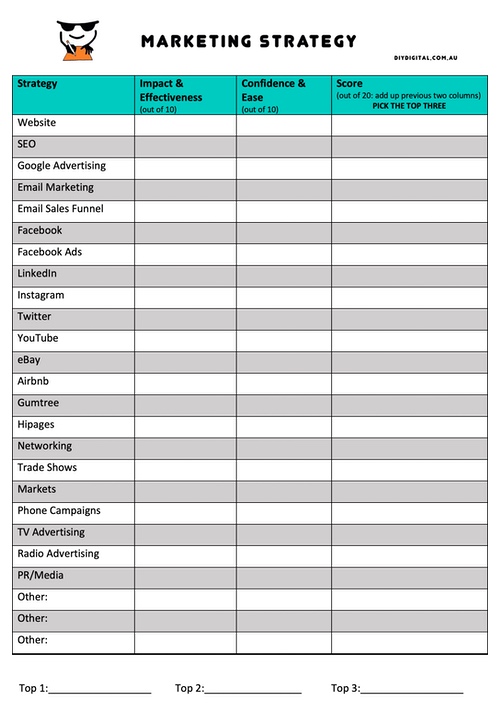
Regularly reviewing your business and marketing plan is a great way to ensure you’ll stay on track. In this article we cover
- practical examples of valuable goals
- hints ‘n tips on how to achieve those goals
- free business plan template for Australian businesses
Business Plan
For a practical and easy to use business plan download our DIY Digital Australian Small Business Plan Template.
This practical business plan will guide you through the key activities for your small business in Australia.
Business Plans are often created for
- a bank to consider a business loan
- a government department for a grant application
- an assignment for a course
The free business plan template provided here is unlikely to meet the requirements for the above uses. Although there is good reason to create the above documents, it’s beyond the scope of this article. If you need a comprehensive financial planning tool or an in-depth template on how to tackle multiple competitors, this plan is not for you.
However, if you want a practical, simple business plan that is useful for you to use in your own business this is the perfect template. The business plan is designed for you to refer to and update every 3 months to keep your business on track.
Business Plan Template
There are five pages in the template:
Page 1: Title Page
Page 2: List of important dates, milestones and products offered
Page 3: Target Market and Marketing Strategy
Page 4: Goal Setting
Page 5: Financials
Don’t feel you need to stick to the template. Create a document that works for you. Use the template to inspire your planning and goal setting. We’re all different and what works for one person doesn’t necessarily work for another. In creating your own marketing plan consider the following:
- What prompts will assist you to think strategically?
- What do you need to be reminded of every now and again for your business success?
- Is a detailed plan going to suit you, or is one with very broad statements enough to keep you on track?
Although there are reasons to create a business plan for other people (eg. banks, grant providers and educational providers) we’d like to think the plan you go back to every three months is entirely for you. Make it your own.
The first three pages rarely need changing. They are included to remind you what your core business is and to keep you on track with your original mission. After being in business for 18months or two years you may wish to change or adjust your mission or strategy. If so, you would update the first few pages in this business plan.
The fifth page is the financials page. On this page you can create a budget or plug in your actual income and expenses from the previous year. It’s very basic and in all likelihood you will need additional financial planning and recording tools for your business. We’ll leave that to our accountant friends to advise on. But we recommend you include the bare basic financials in your plan, as being reminded of, and seeing your broader financial figures on a regular basis, will assist you with your decision making.
The fourth page – Goal Setting is designed to be reviewed and updated every 3 months.
Marketing Plan
Your marketing plan is a chapter or sub-section within your bigger business plan. It is pages 3 and 4 of our five page template and the focus of this article.
The marketing focus of your business plan will have:
- Target market
- Marketing strategy
- Goals
Target Market
Most new business owners (and some established ones) see their target market as everyone. As you’d be happy to sell your product, or provide your service to anyone, it seems a reasonable proposition to say everyone is your target market.
This is a mistake.
By doing so it doesn’t focus your thoughts, energies and activities to the people most likely to buy your product or choose your service.
Describing a target market is not about excluding potential customers. It’s not about identifying who you will sell to. It is about identifying who you are going to market to. There’s a difference. Thinking upon this difference will significantly improve your marketing.
Your energies and resources are best spent marketing to people most likely to buy your product. These people are your target market.
Read our article on customer profile for more about how we recommend you target your marketing.
Marketing strategy
Your marketing plan and strategy is likely to change every few years. As you learn new things, adapt to changing circumstances or develop new services you may find you need to review your marketing plan.
The biggest mistake you can make with your marketing strategy is not having one. If you have no clear way of attracting new customers you will be out of business. Very, very few businesses succeed without proactively getting new customers.
Having a marketing plan prompts you to think about what your strategy is. Reviewing your plan keeps the strategy on track.
In Adelaide, and possibly in many other places, the most successful strategy for many small businesses remains word of mouth. Referrals, networking and getting known by your customers and potential customers is key for almost all small businesses.
Core strategies
At DIY Digital we recommend you have three key strategies in your marketing plan. For example, three core marketing strategies might be:
- Trade shows
- Networking events
or they might be
- Etsy online marketplace
- Stalls and fairs
- SEO
Having three key marketing strategies is enough for you to remember and stay focussed with. It also provides a few options so that if one doesn’t work, you have another two strategies up your sleeve.
The other common mistake around strategy is forgetting you have one. Many business owners start out with the right intentions but then get sidetracked. Slowly and surely, without even realising it, you find yourself spending one hour a day on Facebook, when Facebook isn’t really one of your core strategies.
Housekeeping
It’s helpful to think about marketing strategies as either core strategies or housekeeping activities. For example, if Facebook is your core strategy – spending an hour a day on the platform is an important and valuable activity. But if Facebook for your business is unlikely to significantly grow your business, it’s a housekeeping activity. As a housekeeping activity you might choose to post to the page once a week to ensure people know you are still in business but beyond that you don’t do too much.
Your marketing plan needs only include your core strategies, not your housekeeping ones. Set goals for your important marketing activities.
Goals
Many learned people have written about goals – about how writing them down and sharing them with other people motivates and prompts action. Fitness instructors, dieticians, self-help books – there’s a plethora of stuff written about this. Maybe for you, writing goals down doesn’t work – in which case – ignore this next bit of our article. But I’ve found it has worked for me and share the following to inspire you to set goals in your marketing plan for your business and importantly, review them every three months.
Three months
A three month timeframe for goals works for marketing as it gives you enough time to implement the goal and collect enough data or information to review and analyse the success of it. Any more than three months and your memory and enthusiasm for the goal has likely softened. Any less than three months and there hasn’t been enough time for the goals to be achieved.
On a practical note, it’s also a good length as it matches in with the financial quarter, when businesses need to report on their GST and BAS. So it’s already a timeframe associated with being in business and easy to remember.
So dust of the business plan every quarter, read it, review it and change it as inspiration and motivation kick in.
The New Year is a terrific time to review and update your goals. What’s your New Year’s resolution for your business? What would you really like to see happen this year? Are you already drafting your marketing plan? I hope so!
How many goals?
It’s great to have a one aspirational, big vision two year goal. For example employ first staff member by 1/1/2025 might be a two year goal for your business.
Most businesses will find the following effective:
- 1 x two year goal (broad and descriptive)
- 5 x three month goals (actionable, interval goals updated each quarter with some working towards the two year goal)
Specific, measurable and actionable
Good, clear, actionable goals are an important business driver. Something you can measure and something that will add value to your business, should it be achieved. Page four of our business plan template gives you a few ideas about what to have as goals. For example:
- 10 products sold/month
- 5 quotes given/month
- Establish invoicing system
- Attend five networking events and make connections with 15 new people
- Website on page 1 Google for search term “bathroom renovations in Adelaide”
- 250 website visitors/month
Consider the butterfly test when setting your goals – that is – they should create a little flutter (of nervousness) when you set the number. Not a number so ridiculously high it’s unachievable, but not one so low that it’s too easy.
Activities and Action
The key to achieving goals is action. All the good intentions in the world don’t lead to results unless something is done. To achieve your business goals think about what you need to do to implement them. Break the activity down into tasks. For example if the goal is to increase website visitors to 250 a month, the tasks might be:
- Week 1: undertake keyword research
- Week 2: choose focus keyword for services page
- Week 3: update services page using focus keyword
- Week 4: share services page on social media and in newsletter
- Week 5: undertake advertising on Google for 4 weeks to promote services
Marketing often gets neglected. We often get so busy doing other stuff, we forget about, or don’t prioritise it. Breaking marketing goals into smaller chunks and adding them into your business planner will help.
Here at DIY Digital we use todoist as our task planner. We’ve found it invaluable. There’s many online apps like this available, or maybe the old post-it notes work for you. What-ever your method, add tasks, associated with achieving your goals, to your business planner. It’s easy in business to get busy doing stuff – ensure you are busy doing stuff that is strategically useful!
Review your Marketing Plan
So often businesses make plans and then they gather dust, never to be seen again. Re-reading your marketing plan and the goals you set for yourself can motivate and focus your energies.
A three month review is an ideal time to read and update the marketing plan. It might only be a paragraph here or a bullet point there, but if the plan is not working, or new information comes to hand this is taken into account.
As a sole trader or small business owner it’s up to you to keep yourself on track – and your business and marketing plan is a great way to do it.
Your Marketing Sweet Spot – webinar
Our webinar, ‘How to Find Your Marketing Sweet Spot,’ takes you through a super easy formula to workout the three strategically important marketing channels for your business.
Sign up for the webinar recording and template worksheet here.

